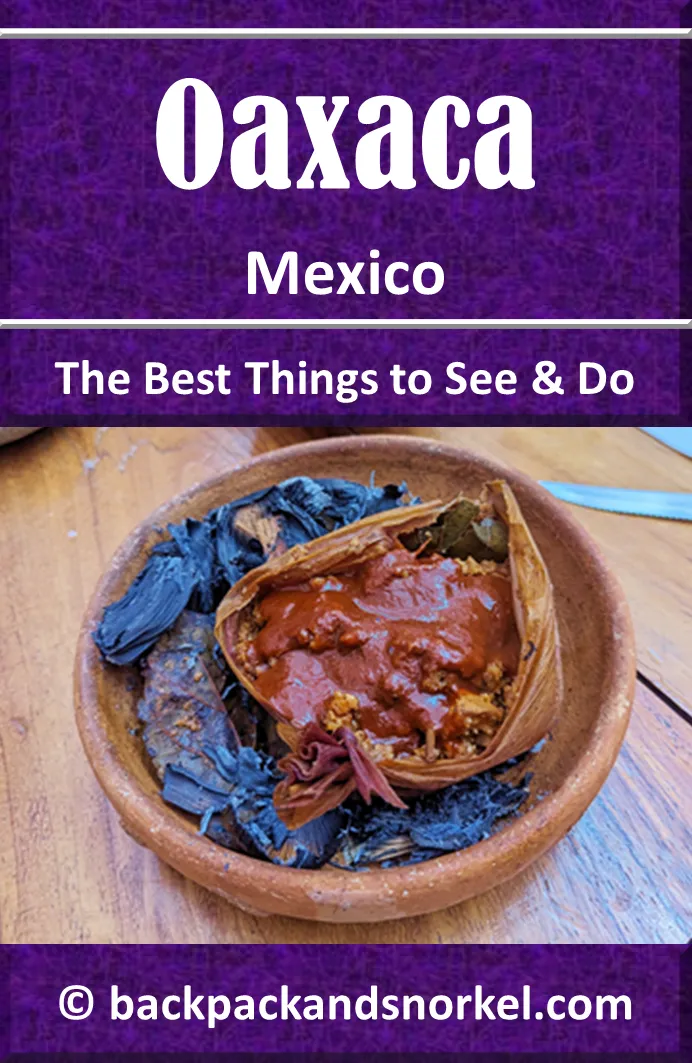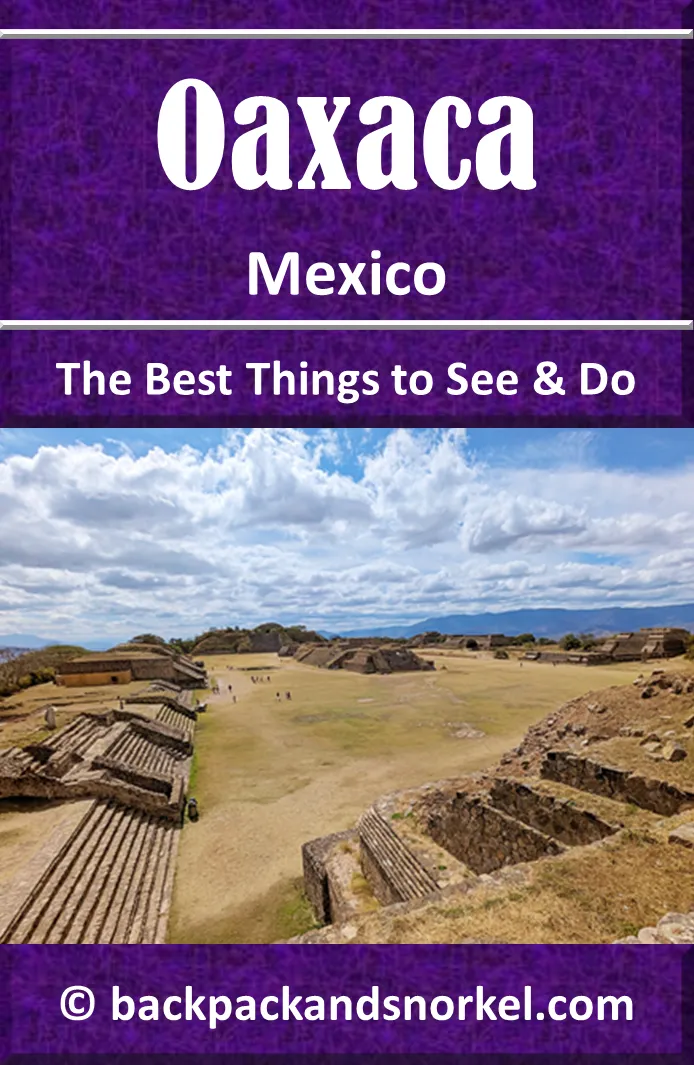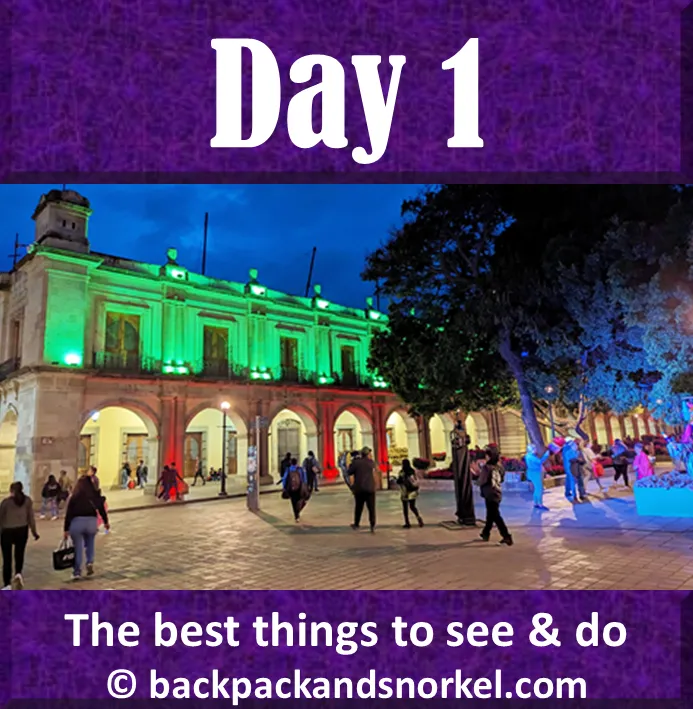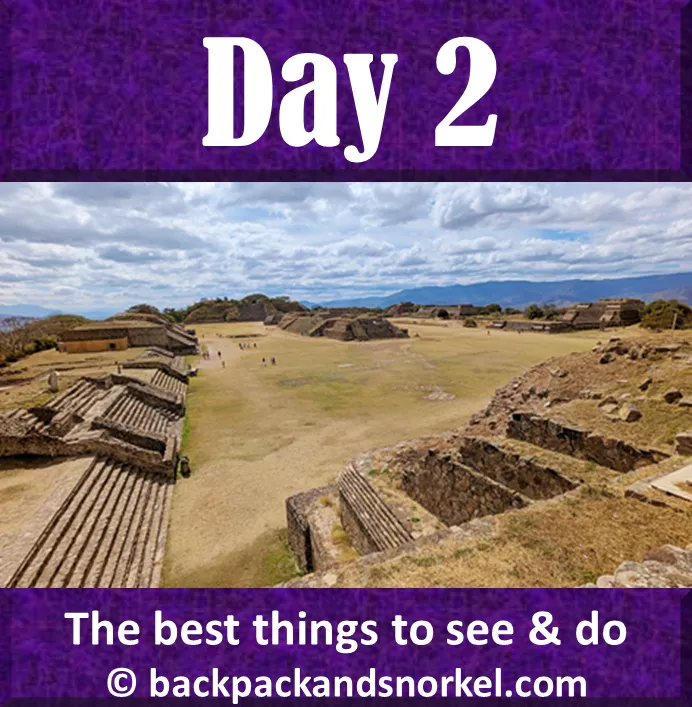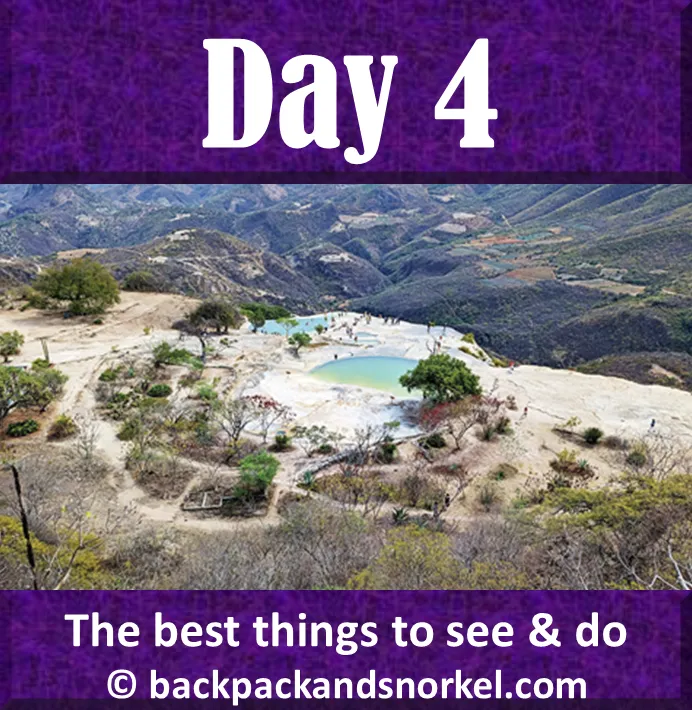Backpack and Snorkel Travel Guide for Day 3: Discovering Mitla and El Tule - Oaxaca Purple Travel Guide
Mitla and El Tule are two excellent destinations outside of Oaxaca. We provide detailed information and the best things to see and we show lots of photos so you know what you can expect.
Today we will explore Oaxaca’s second most important archeological zone, the town of El Tule and we will finish the day with dinner in Oaxaca City.



Here at Backpack and Snorkel Travel Guides, we typically promote self-guided walking tours.
But we realize that not everybody likes to walk by themselves in a foreign city. So, just in case that you rather go with ab guide: NO PROBLEM! Please see the free GuruWalk and paid Viator tours below.
free GuruWalk tours
paid Viator tours
Self-guided walking tour of Zona Arqueologica de Mitla
Monte Alban was the most important Zapotec site politically, and Mitla was the most important religious site for the Mixtec.
Originally established as a sacred burial site by the Zapotec, Mitla’s architecture and designs show a very strong influence of the Mixtec, who had become the dominating force in the area during the peak of Mitla’s settlement.
The name Mitla comes from the Nahuatl (Aztec) name Mictlán, meaning the ‘place of the dead’ or ‘underworld’.
Mitla is unique among Mesoamerican sites, because of its elaborate and intricate mosaics and geometric designs that can be seen everywhere covering walls, tombs, and panels and cannot be found elsewhere in Mexico.
The mosaics are made using small, precisely cut, and polished stone pieces that were pieced together without mortar.
Mitla was inhabited at least since the Classic Period (100 - 650 AD), but possibly as early as 900 BC. Originally built as a fortified village, the oldest buildings date between 450 and 700 AD and have similar architectural features to those found at Monte Alban from the same time.
Starting at around 850 AD, Mitla eventually became the main religious center of the Zapotec. At around 1000 AD, the Mixtec took control of the area, but a sizeable Zapotec population remained. Mitla reached its height between 750 and 1521, when the Spaniards arrived.
In 1553, the Oaxacan Archbishop ordered the destruction of the Mitlan site in the hope of destroying its still important political and religious significance. Spanish forces destroyed the majority of the buildings and later, some Spanish clergy moved into some of the remaining buildings to fully displace the Zapotec who still lived there. Stone blocks from the site were used as building materials for other construction in the area, including the Templo Católico de San Pablo Villa de Mitla, which was built over some of the ruins.
Unlike Monte Alban, the Mitla site was built on the valley floor and therefore lacks the wide vistas and defensive capabilities of Monte Alban. As a religious center, the architecture is built more for the comfort of the residents rather than for magnificence.
The Mitla archeological site consists of five groups of buildings: Grupo del Norte, Grupo de las Columnas, Grupo Del Adobe, Grupo del Arroyo, and Grupo Del Sur.

1 = Grupo del Norte
2 = Templo Católico de San Pablo Villa de Mitla
3 = Grupo de las Columnas
4 = Grupo Del Adobe
5 = Grupo del Arroyo
6 = Grupo Del Sur
All of the buildings in these groups are aligned with the cardinal directions.
The Grupo Del Sur and the Grupo Del Adobe were ceremonial centers. They feature central plazas surrounded by mound structures.
The Grupo Del Sur, Grupo de las Columnas and Grupo del Norte were palaces, with feature rooms surrounding square courtyards.
You can visit all five groups, and the temple.
If you are short on time, our recommendation is to visit at least: Grupo del Norte, Templo Católico de San Pablo Villa de Mitla, and Grupo de las Columnas – all of them can be reached from the same parking lot.
1) Grupo del Norte (North Group)
The North Group is also known as the Church Group. This group can be visited free of charge. You can either enter through the gate at the parking lot, or if the gate is locked, by walking a short detour along Cam. Nacional and entering Reforma (a pedestrian street lined with souvenir stores on both sides).
Grupo del Norte has been fully excavated and restored. The group consists of the main Zapotec temple and the church, 2) Templo Católico de San Pablo Villa de Mitla.
The main Zapotec temple was named the yohopàe = house of the vital force.
It has a large courtyard and the entrance to the temple has one large column on either side. The entrance leads into an entrance room (antechamber), which had a roof that was supported by six columns. The entrance room leads to the main room, where priests made sacrifices, performed rites, and where incense was burned.
Behind the main chamber are the living quarters of the priests, this part is closed to the general public.
The walls in this building are covered by intricate mosaic fretwork and colorful murals used to show mythological scenes and characters.
Under some of the buildings are tombs with more mosaics, but they are off-limits to the general public.

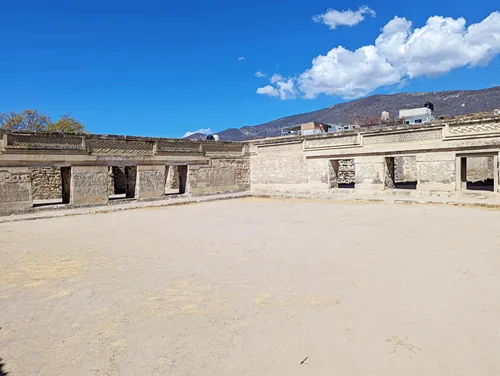
2) Templo Católico de San Pablo Villa de Mitla
The church is part of 1) Grupo del Norte, and sits on top of a large pre-Hispanic platform which, the Zapotec believed, was inhabited by the lord and lady of the underworld.
The Spaniards intentionally covered the platform with the church’s atrium, to emphasize their power, and to keep the ‘devil’ from escaping.
Access to the church is free and either through the pedestrian-only road Reforma, or from the western side on Lazaro Cardenas. All direct access gates from 1) Grupo del Norte are normally locked.
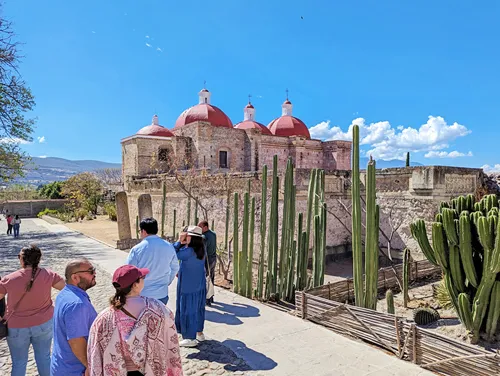
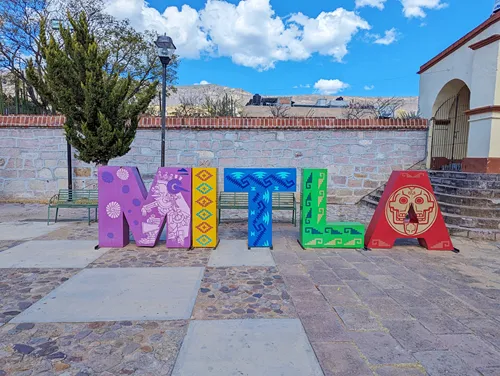
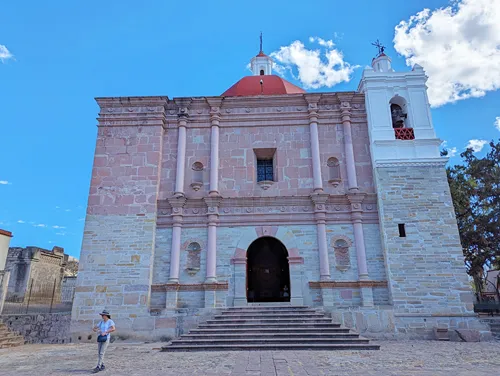
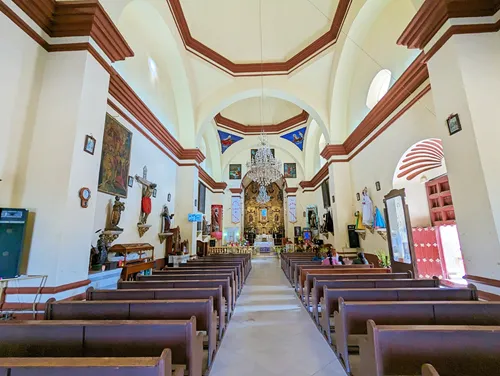
3) Grupo de las Columnas (Columns Group)
Grupo de las Columnas has been fully excavated and restored. Access is only by paid admission at the gate on the pedestrian-only shopping street Reforma.
The main building of this group is called the Palace or, sometimes, the Grand Hall of Columns. This is the structure around the patio in the northern part of the group.
The Palace sits on top of the platform to the north and measures 120 by 21 ft (36.6 m x 6.4 m). The six columns on the inside are made from volcanic stone and were used to support a roof.
You can get there by entering through the patio and climbing up the pyramid to get into the Palace.
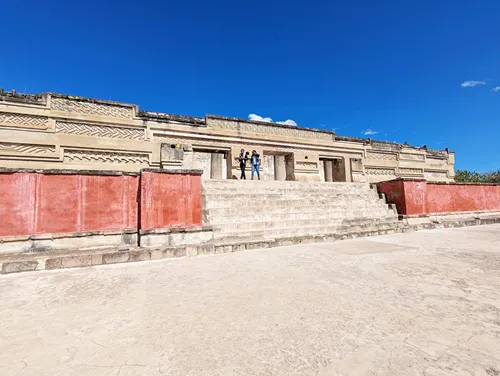
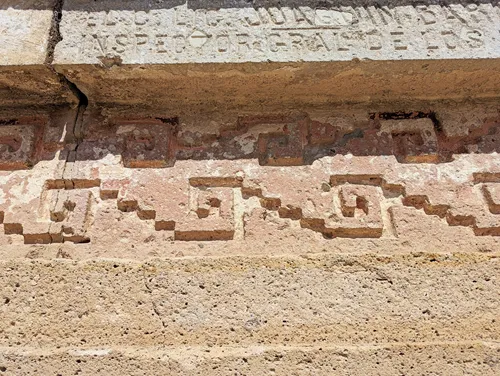
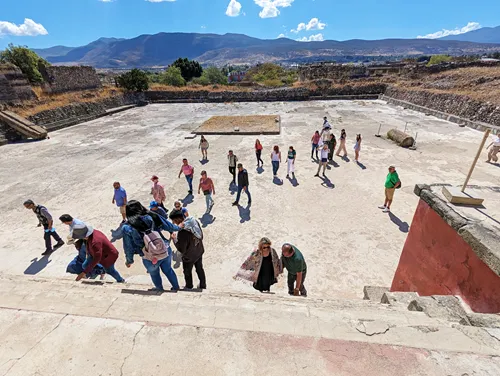
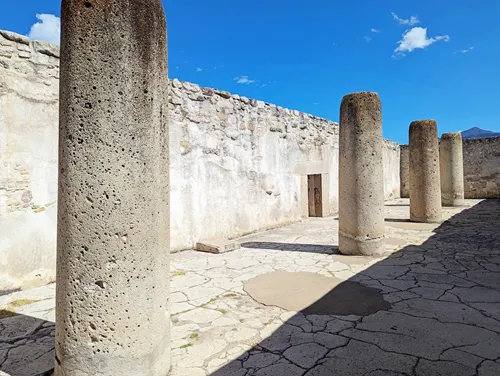
From the Palace, a small hallway leads to a courtyard, which is intricately decorated with mosaic fretwork and geometric designs. Some of the rooms can be entered – they contain even more mosaic fretwork and geometric designs. They were likely used to house Zapotec rulers and high priests.
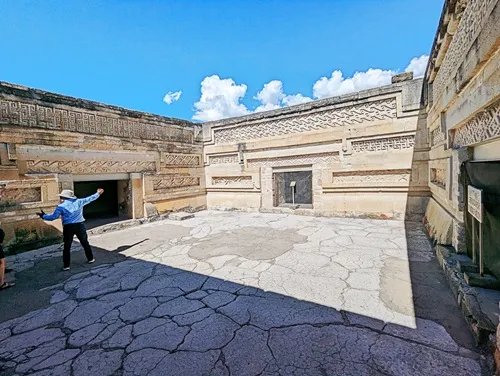
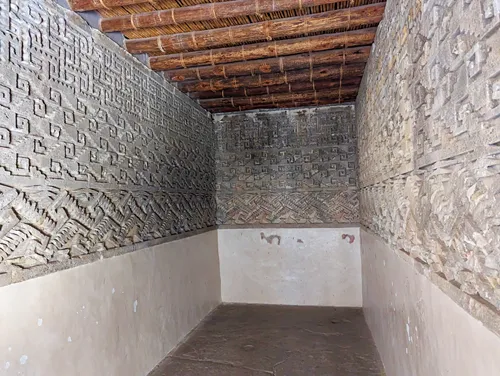
Another patio of the Columns Group sits adjacent to the south-west of the Palace.
The north and east buildings of this patio have elaborate tombs where Zapotec rulers and high priests were buried.
The east building is characterized by a monolithic stone column that supports the roof.
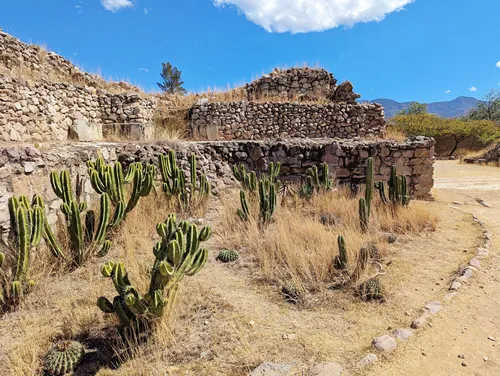
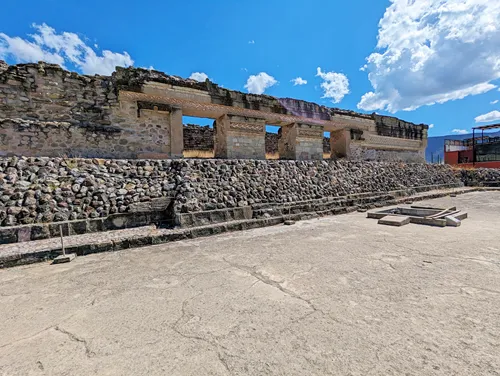
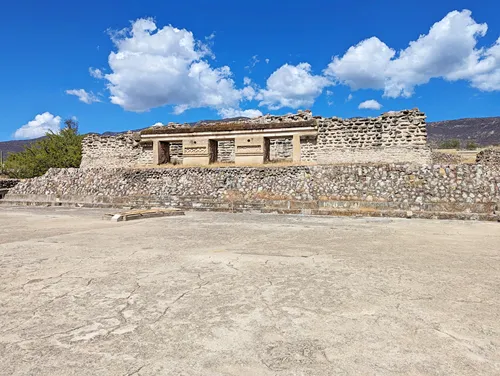
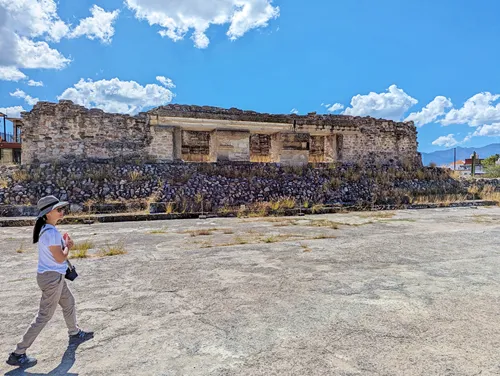
4) Grupo Del Adobe (Adobe Group)
The Adobe Group is also known as the Calvary Group. It lies about 0.25 miles (400 m) west of the entrance of 2) Templo Católico de San Pablo Villa de Mitla.
Not much is left of this group. What you see today is an original small pyramid that was built between 250 AD - 750 AD using adobe bricks. It may be one of the oldest structures in Mitla. The chapel on top of the pyramid was built by the Spaniards in 1674.
You can climb the hill or drive there for a beautiful view of Mitla. The chapel itself is not open to visitors. There is no admission fee to the pyramid.
5) Grupo del Arroyo
About 0.22 miles (350 m) south of 4) Adobe Group lies the Arroyo Group. This group has no admission fee.
The part of the Arroyo Group that can be visited looks similar to the courtyards in the 3) Grupo de las Columnas, but is a little smaller and does not have any remaining intact mosaics or friezes left.
6) Grupo Del Sur
The South Group is the least developed group. It is basically an undeveloped hill (taller than 4) Grupo Del Adobe), from which you supposedly have good views of Mitla.
This ends your self-guided walking tour of Mitla. Walk back to your car and drive back towards Oaxaca, but stop in the town of Santa María del Tule.
Letras Turisticas 'El Tule'
The town of Santa María del Tule is named for its patron saint, the Virgin Mary. The word Tule comes from the Náhuatl (Aztec) word tulle or tullin which means bulrush, which is a type of grass-like flowering plant. Bulrush plants were abundant here in the past, when there was a lake surrounded by marshes full of bulrush plants and cypress trees where the city now stands.
Over time, the lake disappeared, the land was converted into farmland and the city grew to what you see today.
The El Tule sign is one of the first attractions that visitors seek out when visiting town. It is located on the Zocalo, the central town square, which is beautifully maintained.
If you need to use the restrooms, there are public restrooms to the left of the city hall building.


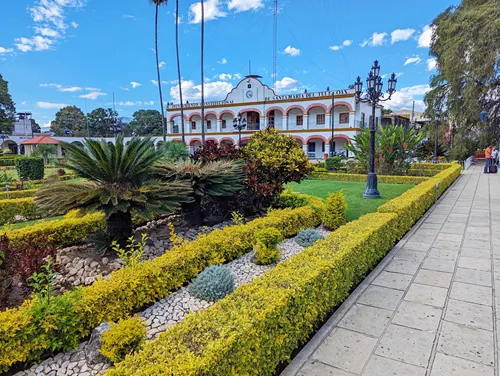
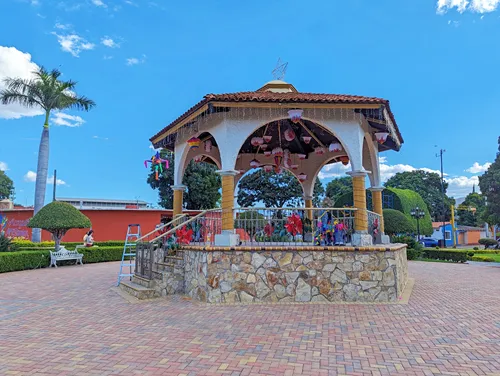
El Tuel Tree / Árbol del Tule
The main reason people visit El Tule is the El Tule Tree: Árbol del Tule.
This tree is one of several old Montezuma cypress trees that grow in town and that are remnants from the marshlands around the lake that used to cover this area.
The El Tule Tree is located in the center of town right next to the Zocalo and the Santa María de la Asunción church.
The El Tule Tree is one of the oldest and largest in the world and it is sacred to the indigenous people of this area.
Its age is likely at least 2,000 years, and its existence was mentioned by the Aztecs and later by the Spanish.
The recorded measurements are:
- Height: 40 m (131 ft)
- Volume: 700 – 800 m3 (915 – 1050 cubic yards)
- Estimated weight: 630 tons (1.4 mio lbs)
- Circumference: 40 m (131 ft) = widest girth of any tree on the planet
According to legend, a king named Conday stuck his walking stick into the ground, rested on it and eventually died. After his death, the stick started to grow and developed into the El Tule Tree.
Portions of the trunk, and some branches look like animals and they are sources for local legends. If you visit with a local guide, they will point out the elephant, deer, pineapple, fish, lion, etc. to you.
You can get close to the tree if you pay 20 Pesos admission, which also allows you to visit the adjacent church: Templo de Santa María de la Asunción.

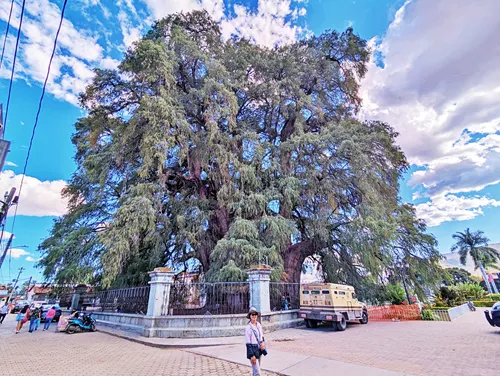
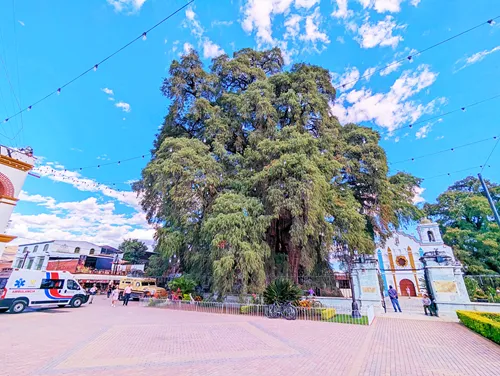

Templo de Santa María de la Asunción
Directly next to the El Tule Tree stands the Baroque-style church Templo de Santa María de la Asunción (Temple of the Virgin Mary of the Assumption). It was built in the 18th century and it costs 20 Pesos (at the time of writing) to enter the fenced area that surrounds the church and the El Tule Tree.
The interior of the church contains several pre-colonial statues of saints.
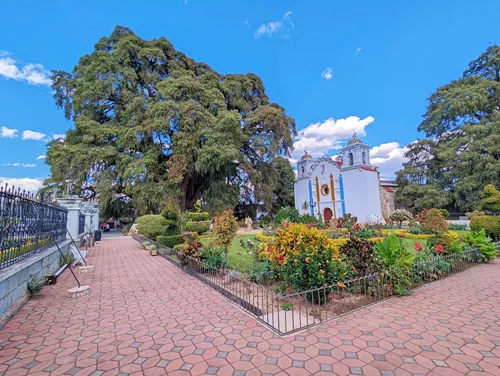
Mercado Gastronómico de Santa María del Tule
This is a typical Mexican dining hall with probably 20 food stands that serve various types of typical Mexican foods (e.g. quesadillas and enmoladas), but also local foods like barbacoas and mole dishes. As the prices are very reasonable, the mercado will get busy during breakfast, lunch, and dinner times.
When you enter, be prepared to be approached by several vendors who try to direct you to their food stands.
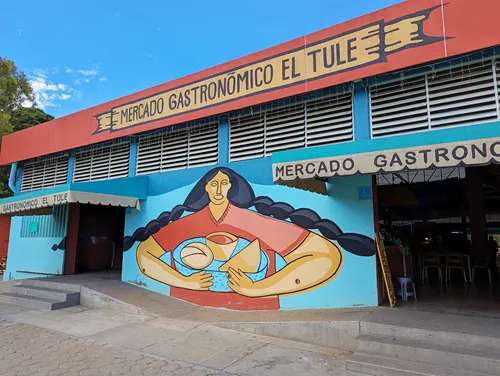

This concludes your visit to Santa María del Tule. Get back to your car and drive to Oaxaca City.
Mercado 20 de Noviembre
Directly south of Mercado Benito Juarez lies Mercado 20 de Noviembre. Mercado 20 de Noviembre focuses on vendors that sell fresh produce and it has lots of good small restaurants. Mercado Benito Juarez has those, too, but there are more non-food vendors that sell, e.g. souvenirs, flowers, kitchen hardware.
Because of the tasty food, we recommend visiting Mercado 20 de Noviembre for dinner and, if you feel like it, for lunch.
You can get good authentic Tlayudas at several food stands in the mercado. Alternatively, you can get them a few block south of here at Tlayudas La Chinita after 8pm.


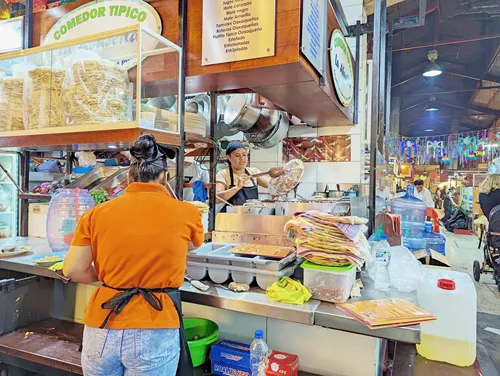

Tlayudas La Chinita (after 8pm)
Tlayudas La Chinita are probably the most popular Tlayudas street vendor in Oaxaca. Every night starting at 8pm, do they start handmaking their Tlayudas and selling them. As this is a street vendor, there is no place to sit, so you need to eat your order right there or take it with you to consume it somewhere else.
The long lines that start forming shortly before 8pm are a testament to the high quality of their Tlayudas.

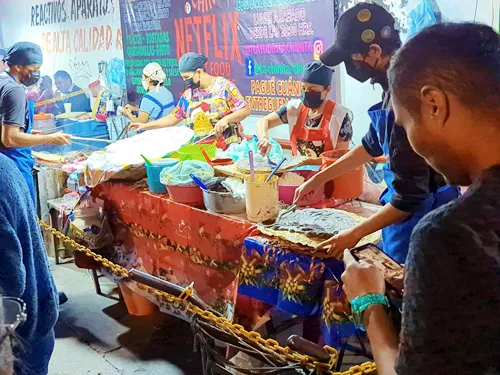
This concludes your third day in Oaxaca.
Where do you want to go now?
Author: Rudy at Backpack and Snorkel
Bio: Owner of Backpack and Snorkel Travel Guides. We create in-depth guides to help you plan unforgettable vacations around the world.
Other popular Purple Travel Guides you may be interested in:
Like this Backpack and Snorkel Purple Travel Guide? Pin these for later:
